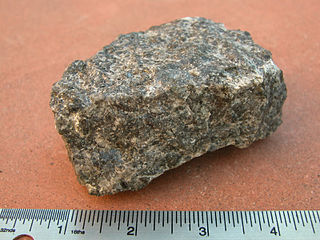
Gabbro is a phaneritic, mafic intrusive igneous rock formed from the slow cooling magma into a holocrystalline mass deep beneath the Earth's surface. Slow-cooling, coarse-grained gabbro is chemically equivalent to rapid-cooling, fine-grained basalt. Much of the Earth's oceanic crust is made of gabbro, formed at mid-ocean ridges. Gabbro is also found as plutons associated with continental volcanism. Due to its variant nature, the term gabbro may be applied loosely to a wide range of intrusive rocks, many of which are merely "gabbroic". By rough analogy, gabbro is to basalt as granite is to rhyolite.

Dacite is a volcanic rock formed by rapid solidification of lava that is high in silica and low in alkali metal oxides. It has a fine-grained (aphanitic) to porphyritic texture and is intermediate in composition between andesite and rhyolite. It is composed predominantly of plagioclase feldspar and quartz.

Nepheline syenite is a holocrystalline plutonic rock that consists largely of nepheline and alkali feldspar. The rocks are mostly pale colored, grey or pink, and in general appearance they are not unlike granites, but dark green varieties are also known. Phonolite is the fine-grained extrusive equivalent.
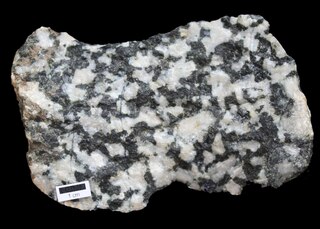
Diorite is an intrusive igneous rock formed by the slow cooling underground of magma that has a moderate content of silica and a relatively low content of alkali metals. It is intermediate in composition between low-silica (mafic) gabbro and high-silica (felsic) granite.
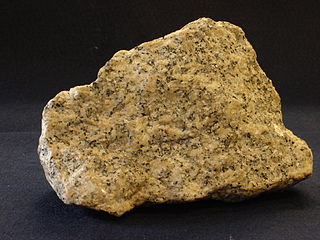
A granitoid is a generic term for a diverse category of coarse-grained igneous rocks that consist predominantly of quartz, plagioclase, and alkali feldspar. Granitoids range from plagioclase-rich tonalites to alkali-rich syenites and from quartz-poor monzonites to quartz-rich quartzolites. As only two of the three defining mineral groups need to be present for the rock to be called a granitoid, foid-bearing rocks, which predominantly contain feldspars but no quartz, are also granitoids. The terms granite and granitic rock are often used interchangeably for granitoids; however, granite is just one particular type of granitoid.
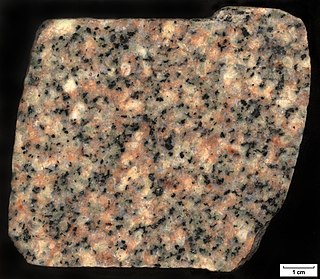
Quartz monzonite is an intrusive, felsic, igneous rock that has an approximately equal proportion of orthoclase and plagioclase feldspars. It is typically a light colored phaneritic (coarse-grained) to porphyritic granitic rock. The plagioclase is typically intermediate to sodic in composition, andesine to oligoclase. Quartz is present in significant amounts. Biotite and/or hornblende constitute the dark minerals. Because of its coloring, it is often confused with granite, but whereas granite contains more than 20% quartz, quartz monzonite is only 5–20% quartz. Rock with less than five percent quartz is classified as monzonite. A rock with more alkali feldspar is a syenite whereas one with more plagioclase is a quartz diorite. The fine grained volcanic rock equivalent of quartz monzonite is quartz latite.

Intrusive rock is formed when magma penetrates existing rock, crystallizes, and solidifies underground to form intrusions, such as batholiths, dikes, sills, laccoliths, and volcanic necks.

Lamprophyres are uncommon, small-volume ultrapotassic igneous rocks primarily occurring as dikes, lopoliths, laccoliths, stocks, and small intrusions. They are alkaline silica-undersaturated mafic or ultramafic rocks with high magnesium oxide, >3% potassium oxide, high sodium oxide, and high nickel and chromium.

Essexite, also called nepheline monzogabbro, is a dark gray or black holocrystalline plutonic igneous rock. Its name is derived from the type locality in Essex County, Massachusetts, in the United States.

Granodiorite is a coarse-grained (phaneritic) intrusive igneous rock similar to granite, but containing more plagioclase feldspar than orthoclase feldspar.
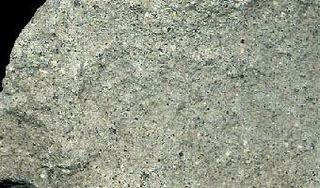
Rhyodacite is a volcanic rock intermediate in composition between dacite and rhyolite. It is the extrusive equivalent of those plutonic rocks that are intermediate in composition between monzogranite and granodiorite. Rhyodacites form from rapid cooling of lava relatively rich in silica and low in alkali metal oxides.

A quartz latite is a volcanic rock or fine grained extrusive rock composed mostly of alkali feldspar and plagioclase with some quartz. It forms from the rapid cooling of magma of intermediate composition but moderately enriched in alkali metal oxides.

A QAPF diagram is a doubled-triangle plot diagram used to classify intrusive igneous rocks based on their mineralogy. The acronym QAPF stands for "Quartz, Alkali feldspar, Plagioclase, Feldspathoid (Foid)", which are the four mineral groups used for classification in a QAPF diagram. The percentages (ratios) of the Q, A, P and F groups are normalized, i.e., recalculated so that their sum is 100%.
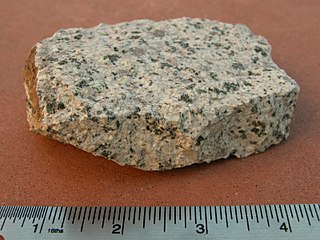
Monzonite is an igneous intrusive rock, formed by slow cooling of underground magma that has a moderate silica content and is enriched in alkali metal oxides. Monzonite is composed mostly of plagioclase and alkali feldspar.

Quartz diorite is an igneous, plutonic (intrusive) rock, of felsic composition, with phaneritic texture. Feldspar is present as plagioclase with 10% or less potassium feldspar. Quartz is present at between 5 and 20% of the rock. Biotite, amphiboles and pyroxenes are common dark accessory minerals.

Igneous rock, or magmatic rock, is one of the three main rock types, the others being sedimentary and metamorphic. Igneous rocks are formed through the cooling and solidification of magma or lava.

Trachybasalt is a volcanic rock with a composition between trachyte and basalt. It resembles basalt but has a high content of alkali metal oxides. Minerals in trachybasalt include alkali feldspar, calcic plagioclase, olivine, clinopyroxene and likely very small amounts of leucite or analcime.
Quartz gabbro is an intrusive rock with a composition intermediate between gabbro and tonalite. It is defined in the QAPF classification as coarse-grained igneous rock in which quartz makes up 5% to 20% of the QAPF mineral fraction, plagioclase makes up 90% or more of the total feldspar content, and the plagioclase is calcium-rich.
Monzodiorite is an intrusive rock with a composition intermediate between diorite and monzonite. It is defined in the QAPF classification as coarse-grained igneous rock in which quartz makes up 0% to 5% of the QAPF mineral fraction, plagioclase makes up 65% to 90% of the total feldspar content, and the plagioclase is sodium-rich.



















